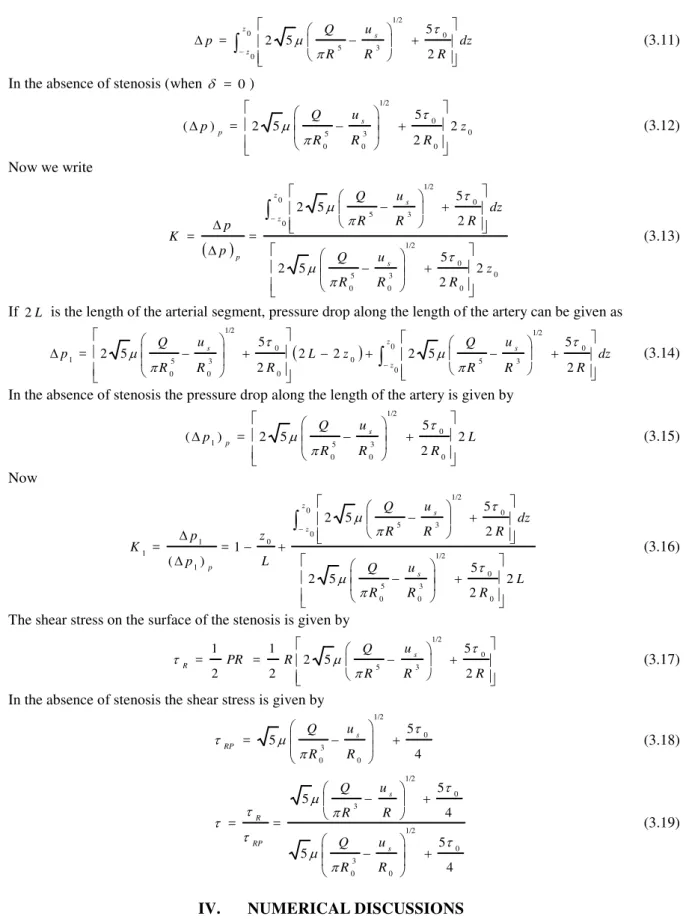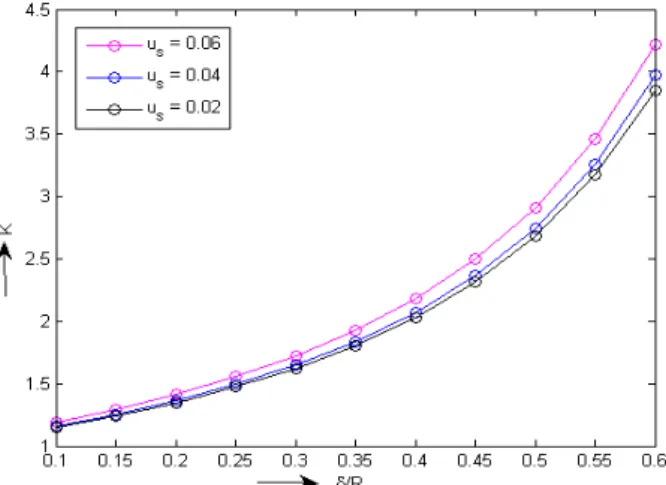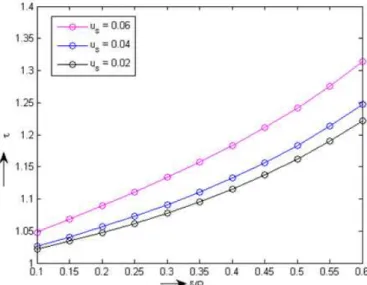American Journal of Engineering Research (AJER)
e-ISSN: 2320-0847 p-ISSN : 2320-0936
Volume-5, Issue-12, pp-326-333
www.ajer.org
Research Paper Open Access
Role of Arterial Stenosis on Non-Newtonian Flow of Blood in
Presence of Slip Velocity
Arun Kumar Maiti
(Department of Mathematics, Shyampur Siddheswari Mahavidyalaya, India)
ABSTRACT:
An attempt has been made to study the role of arterial stenosis on blood flow in presence of slip velocity. In the present analysis Herschel-Bulkley fluid represents the non-Newtonian character of blood. The hemodynamic behaviour of blood flow is influenced by the presence of arterial stenosis. The expressions for velocity profile, pressure drop and shear stress have been investigated here. The results are shown in graphical form.Keywords:
Herschel-Bulkley fluid, Shear Stress, Yield Stress, Stenosis, Resistance to flow.I.
INTRODUCTION
Many cardiovascular diseases, such as stroke, atherosclerosis, which are responsible for major cause of death, are closely related to the nature of blood flow and the dynamic behaviour of blood vessels. It is well known from medical point of view that many cardiovascular diseases directly depend on various types of arterial diseases. Among the arterial diseases the most important one is stenosis. The medical term stenosis means narrowing of body passage, including blood vessels, heart valves, vertebral canal, G. I. tract. It is believed that stenosis is formed by the accumulation of fatty substances like cholesterol or fats in the inner wall of the artery and proliferation of connecting cells. If stenosis is present in an artery, the blood flow changes to its usual state, because resistance to flow is increased and as a result supply of oxygen to each cell of the body and removal of carbon dioxide is disturbed abruptly. In other words nutrient supplement is insufficient to reach each cell of the body. Many bio-medical researchers (Shukla et. al. [1], Young and Tsai [2], Verma and Parihar [3]) feel that the hemodynamic factors may be helpful in the diagnosis, treatment and understanding of many disorders. Misra and Shit [4] have developed a mathematical model to study the non-Newtonian aspect of blood flow by using Herschel-bulkley fluid model in presence of arterial stenosis and they have shown that skin friction and resistance to flow is maximum at the throat of the stenosis and minimum at the end. Ali et. al. [5] have analysed the effect of an axial symmetric time dependent growth along the lumen of the arterial tube by considering blood as a Newtonian fluid. Biswas and Chakraborty [6], srivastava et. al. [7] have studied non-Newtonian behaviour of blood through a stenosed artery. Shah and Siddiqui [8] have studied a mathematical model to analyze the effect of peripheral layer viscosity on blood flow through stenosed arterial tube by considering the blood as power-law type non-Newtonian fluid. They have seen that the peripheral layer viscosity of blood in diabetic patients is higher than in non-diabetic patients, resulting higher resistance to flow.So peripheral layer viscosity has significant effects on resistance to flow. Thus resistance to blood flow of diabetic patients may be reduced by reducing the plasma layer viscosity.
Many researchers (Vershney et. al. [9], Singh and Shah [10], Sankar and Hemalatha [11], Sankar [12], Sanyal and Maiti [13]) have presented various types of mathematical models to study various characteristics of blood by considering blood as a non- Newtonian fluid. Many investigators (Nuber [14], Haymen [15], Chaturani and Biswas [16], Kumar et. al. [17], Biswas and Chakraborty [18], Chaturani and Ponalagusamy [19]) have analysed theoretically the blood flow model through uniform artery in presence of slip velocity to study the flow parameters of blood.
Z
0Z
0u
sL
L
R
0R
r
Z
δ
Fig. 1: Geometry of the arterial segment with stenosis.
II.
MATHEMATICAL
FORMULATION
Let us consider the steady one dimensional laminar flow of blood through an axially symmetric and radially non-symmetric constricted artery. The geometry of bell shaped stenosis can be taken as [4]
2 0
2 2 2
0 0 1
=
R z m exp R R z
R (2.1)
Where R(z) is the radius of the arterial tube in the stenotic region, R0 is the normal radius of the
artery, is the maximum height of the stenosis, m is a parametric constant and characterises the relative length of the constriction, defined as the ratio of the radius to half length of stenosis,
2
0
1
= a exp bz
R z R
(2.2)
where,
2 0 2 2
0
= , =
R m b R
a
The equations governing the motion are given by
) ( 1 =
0 r
r r z p
(2.3)
r p
=
0 (2.4)
Let us consider the blood as a Herschel-Bulkley type fluid, the constitutive equation for Herschel-Bulkley fluid is given by
= 0, 0
n
r u
(2.5)
= 0, < 0
r u
(2.6)
Boundary conditions are
(i) u = us at r = R(z), (slip condition)
(ii) is finite at r = 0,(regularity condition)
III.
SOLUTIONS
From (2.1),
2 = Pr
For simplicity we take the Herschel-Bulkley fluid index as
2 1 =
r u = 2 0 (3.1)
Which can be written as
2 0 2 2 1 = Pr r u (3.2)
From which we get after integration
A r Pr
r P
u
2 0 0 2 3 2 2 2 12 1 =
(3.3)
Using the boundary condition (i) we get
P R r P R r R r
u
u s 3 3 0 2 2 02
2 2 2 12 1 =
(3.4)
In the absence of stenosis (i.e., when = 0 ), the axial velocity is given by
P R r P R r R r
u
up s 03 3 0 02 2 02 0
2 2 2 12 1 =
(3.5)
where the subscript p denotes the Poiseuille flow.
r R r R P r R P u r R r R P r R P u u u s s p 0 2 0 2 2 0 0 3 3 0 2 2 2 0 2 2 0 3 3 2 2 2 12 1 2 12 1 = (3.6)Volumetric flow rate i.e., the flux is given by
2 3 2 0 2 4 0 2 5 2 20 20 4 3
. = 2 =
r dr u R P R P R R
u
Q s
R
(3.7)
From which we can write
2 2 0 2 2 0 2 3 2 2 3 4 20 = R R P R P u R Q
s
(3.8)
3 2 5 = 2 0 0 2 2 R R R
Since =1
R o , replacing 3 1 by 16 5
we finally get
16 25 4 10 5 = 2 0 0 2 2 2 R R s R u R Q (3.9) 2 0 2 4 5 5 = R R
Thus we get from above
R R Q R R P s 2 5 5 2 = 0 1/2 2 2
(3.10)
R R u R Q s 2 5 5 2 = 0 1/2 3 5
dz R R u R Q p s z z
2 5 5 2 = 0 1/2 3 5 0 0 (3.11)
In the absence of stenosis (when = 0)
0 0 0 1/2 3 0 5 0 2 2 5 5 2 = ) ( z R R u R Q
p p s
(3.12)
Now we write
0 0 0 1/2 3 0 5 0 0 1/2 3 5 0 0 2 2 5 5 2 2 5 5 2 = = z R R u R Q dz R R u R Q p p K s s z z p
(3.13)If 2L is the length of the arterial segment, pressure drop along the length of the artery can be given as
dzR R u R Q z L R R u R Q p s z z s
2 5 5 2 2 2 2 5 5 2 = 0 1/2 3 5 0 0 0 0 0 1/2 3 0 5 0 1 (3.14)
In the absence of stenosis the pressure drop along the length of the artery is given by
L R R u R Q
p p s 2
2 5 5 2 = ) ( 0 0 1/2 3 0 5 0 1
(3.15)
Now L R R u R Q dz R R u R Q L z p p K s s z z p 2 2 5 5 2 2 5 5 2 1 = ) ( = 0 0 1/2 3 0 5 0 0 1/2 3 5 0 0 0 1 1 1
(3.16)The shear stress on the surface of the stenosis is given by
R R u R Q R PR s R 2 5 5 2 2 1 = 2 1 = 0 1/2 3 5
(3.17)
In the absence of stenosis the shear stress is given by
4 5 5 = 0 1/2 0 3 0 R u R Q s RP (3.18) 4 5 5 4 5 5 = = 0 1/2 0 3 0 0 1/2 3 R u R Q R u R Q s s RP R (3.19)
IV.
NUMERICAL
DISCUSSIONS
To illustrate the flow analysis, the results are shown graphically with the help of MATLAB-7.6. The effects of various parameters on pressure drop, axial velocity and wall shear stress are calculated here.
Figure 2 describes the effect of stenosis on axial velocity with respect to the axial distance z . It is observed from the figure that axial velocity decreases with the increase of stenosis size.
stress for the increase of a and b . But it increases as slip velocity increases with the increase of stenosis size. Similar behaviour of the pressure drop K1 across stenosis size a and b can be seen in Figures 7-9. It is also
observed that pressure drop K1 increases with the increase of stenosis length.
Figures 10-11 show the effects of slip velocity on shear stress with respect to stenosis size. It is clear from the figures that shear stress increases with the increase of slip velocity.
Fig. 2: Variation of axial velocity for different values of stenosis size.erent values of stenosis size.
Fig. 3: Variation of Pressure drop K across the stenosis size for different values of yield stress.
Fig. 5: Variation of Pressure drop K with respect to b for different values of yield stress.
Fig. 6: Variation of Pressure drop K with respect to b for different values of slip velocity.
Fig. 8: Variation of Pressure drop K1with respect to stenosis size for the variation of slip velocity.
Fig. 9: Variation of Pressure drop K1 with respect to b for the variation of slip velocity.
Fig. 11: Variation of shear stress across the stenosis size with the variation slip velocity. V.
CONCLUSIONS
The velocity profile, pressure drop and wall shear stress have been studied here in presence of slip velocity at the arterial wall. Many cardiovascular diseases such as stroke, hypertensions persist due to the arterial stenosis. In such diseased condition, blood behaves as a non-Newtonian fluid. It is seen that the axial velocity decreases with increase of stenosis size in presence of slip velocity, but pressure drop increases. So the present analysis may be useful for further study relating to blood flow characteristics in various types of cardiovascular diseases.
REFERENCES
[1]. J. B. Shukla, R. S. Parihar, B. R. P. Rao: Effects of stenosis on non-Newtonian flow of the blood in an artery. Bull. Math. Biol. 42 (1980), 283–294. Zbl 0428.92009.
[2]. D. F. Young, F. Y. Tsai: Flow characteristics in models of arterial stenoses—I. Steady flow. Journal of Biomechanics 6 (1973), 395-410.
[3]. N. Verma, R. S. Parihar: Mathematical model of blood flow through a tapered artery with mild stenosis and hematocrit. J. Mod. Math. Stat. 4 (2010), 38-43. MR2670467.
[4]. J. C. Misra and G. C. Shit: Blood flow through arteries in a pathological state: a theoretical study. Int. J. Eng. Sci. 44 (2006), 662– 671. Zbl 1213.76267.
[5]. R. Ali, R. Kaur, V. K. Katiyar, M. P. Singh: Mathematical modeling of blood flow through vertebral artery with stenoses. Indian Journal of Biomechanics, special issue NCBM, (2009).
[6]. D. Biswas, U. S. Chakraborty: Pulsatile flow of blood in a constricted artery with body acceleration. Appl. Appl. Math. 4 (2009), 329–342. Zbl 1178.76390.
[7]. V. P. Srivastava, R. Vishnoi, S. Mishra, P. Sinha: Blood flow through a composite stenosis in catheterized arteries. e- Journal of Science and Technology (e-JST) 4 (2010), 55-64.
[8]. S. R. Shah, S. U. Siddiqui: Two phase model for the study of blood flow through stenosed artery. Int. Journal of Pharmacy and Biological Sciences, 1 (2011), 246-254.
[9]. G. Varshney, V. K. Katiyar, S. Kumar: Effect of magnetic field on the blood flow in artery having multiple stenosis: A numerical study. International Journal of Science and Technology, 2 (2010), 67-82.
[10]. S. Singh, R. R. Shah: A numerical model for the effect of stenosis shape on blood flow through an artery using power-law fluid. Advances in Applied Science Research, 1 (2010), 66-73.
[11]. D. S. Sankar, K. Hemalatha: Pulsatile flow of Herschel-Bulkley fluid through stenosed arteries – a mathematical model. Int. J. Non-Linear Mech. 41 (2006), 979–990. Zbl 1160.76446.
[12]. D. S. Sankar: A two-fluid model for pulsatile flow in catheterized blood vessels. Int. J. Non-Linear Mech. 44 (2009), 337–351. Zbl 1203.76184.
[13]. D. C. Sanyal and A. K. Maiti: On steady and pulsatile motion of blood. Czech. J. Phys. 48 (1998), 347–354. Zbl 1044.76520 [14]. Y. Nuber: Blood flow, Slip and Viscometry. J. Biophys. 11 (1971), 252-264.
[15]. W. A. Hyman: The role of slip in the rheology of blood. Biorheology 10 (1973), 57-60.
[16]. P. Chaturani, D. Biswas: A theoretical study of blood flow through stenosed artery with velocity slip at the wall, Proc. Internat. Symposium on Physiological Fluid Dynamics, IIT, Madras, India, 23-26.
[17]. S. Kumar, C. Diwakar: A Mathematical model of power-law fluid with an application of blood flow through an artery with stenosis. Advances in Applied Mathematical Biosciences, 4 (2013), 51-61.
[18]. D. Biswas, U. S. Chakraborty: Two-layered pulsatile blood flow in a stenosed artery with body acceleration and slip at wall. Appl. Appl. Math. 5 (2010), 1400-1417. Zb1 1205.76311, MR2747833.
[19]. P. Chaturani, V. R. Ponnalagarsamy: A study of non-Newtonian aspects of blood flow through stenosed arteries and its applications in arterial diseases. Biorheology, 22 (1985), 521-531.





